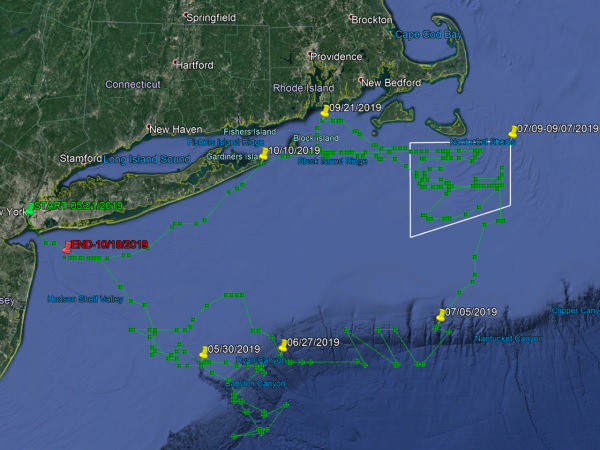Also See:
Jeff Nail’s Lake Lanier Bass Fishing Report
Lake Hartwell Fishing Report from Captain Mack
Lake Lanier Fishing Report from Captain Mack
Lake Guntersville Weekly Fishing Report from Captain Mike Gerry
Lake Country Fishing – fishing reports on Lakes Sinclair and Oconee, and more. (subscription required)
Texas Parks and Wildlife Weekly Freshwater Fishing Reports
Texas Parks and Wildlife Weekly Saltwater Reports
Lake Lanier Fishing Report from Captain Mack
The first weekend of May might be a little on the soggy side, with warm temps and a light to
moderate south winds. Hmmm… sounds like pretty good fishing weather to me. The extended
forecast indicates lots of cloud cover through the week, and an increasing chance of rain late in
the week. The bite reminds pretty good for Bass and Stripers, although we are seeing some
changes with the warming water temps. The lake level dropped last week, .28 feet, to a level of
1071.23 that is .23 above full pool. We’ll call the core surface temp 72 degrees.
Remember to
be sure and tune into Capt Macks Epic Outdoors Radio each Saturday AM, 4 to 6 am. on WSB
750 Am. Yeah, it’s early, but I’ll be up with a pot of coffee and some Fig Newtons waiting to take
your hunting and fishing calls.
Striper Fishing
The bite is good, and the techniques are really the same as recent weeks. The fish are also
using the same types of structures and areas, with maybe a little more emphasis on the Herring
spawn. The fish are pretty catchable when you find them so stay in the move until you locate
them. Free lines and planers continue to account for good numbers of fish, but the down lines
are still producing and are perhaps a bigger part of the pattern than in the last few weeks. Keep
in mind the floating down lines, they are often a good technique at this point in the year. Herring
and Gizzard Shad are catching fish, with shiners also still being effective, the shiners mostly on
the free lines. Pulling the baits around shallow humps, reef poles, and points is a solid pattern,
best in the am, but effective all day.
Looking for the spawning bait fish remains a good strategy, find the bait fish spawns and the
Stripers will likely be nearby. Shad and Herring may spawn on almost any type of rock or hard
surface. Look around the ridge pilings, seawalls, rip rap or rocky banks. The fish that are around
the bait concentrations may be shallow, especially early. After the bait fish activity slows or
ceases, the Stripers may stay in the same area, just backing off into deeper water and relating
very loosely to the structure.
The pitch bite remains very, very good, perhaps one of our most prolific patterns each year. To
respond to a couple of questions; What exactly is pitching? It is just finding a likely structure that
is holding fish, securing the boat with spot lock shallow water anchors, and casting or “pitching’
a live bait, on Lanier general a Herring to the structure. Easy enough, but there are a couple of
pointers there will catch more fish. Firstly, once you pitch, lob may be a better description, to the
point, fish with your rod tip low. The reason being, many of the fish, especially the Stripers will
eat the bait and swim towards the boat, fast! Maybe faster than you can reel. If you rod tip is
high, you lose the benefit of being able to lift the rod on the bite which gives you the ability to
take up several feet of line, aka slack. Also, I prefer not to set the hook, but just start cranking
until you feel the weight of the fish, then lift the rod, keep reeling and that should get the hook
set. I prefer a circle hook over the octopus for the pitching technique
Bass Fishing
April Was a very good month, it’s early, so far it looks like May will continue that trend! The
patterns of the last few days are continuing, I think we can just add in a few post spawn patterns
that are emerging. Are the fish still spawning? I think so, however, I think there was a big group
of fish that spawned on that last full moon that be will be finishing up soon. I still think we will
have another group of spawning fish, maybe not as big as last month, so the shallow water
patterns will still have merit, we’ll just have some post spawn patterns to add variety.
With water
temps in the low 70’s we should have shallow fish anyway, regardless of the spawn.
You’ll still have the advantage of catching fish on many baits, the same baits that have been
effective in recent weeks will still be catching fish. The soft plastics, jerk baits, spinnerbaits,
swim baits (both soft plastics and hard baits)and top waters continue to produce. One footnote
on the spinnerbait bite I have discussed so much recently: as the fish leave the banks the
spinnerbaits will still have application. The technique is the same as mentioned in earlier
reports, just deeper. Fish the bait slowly enough that is following the slope of the bottom to get
the bait down into 5 to 12 feet. a heavier bait may also be a plus in getting into the appropriate
depth range. Banks with cover will still hold fish, it will most likely be that shallow offshore
structures will be more prolific. Target long flat points, shallow humps, deep stump flats and
shallow brush tops.
Keep an eye on the spawning Herring, find them and you find the fish. What to cast? Again, lots
of choices will get the bite. Sashimmy Shads and Lanier Baits Magic Swimmers, are a couple of
consistent producers. Soft plastics on the lead head, and top waters should all get the bite. The
same baits will have application for any schooling fish you see chasing bait, and that is
occurring frequently now!
Good Fishing!!
Capt Mack

 Radlof says the bass are primarily feeding on adult bunker inshore.
Radlof says the bass are primarily feeding on adult bunker inshore. 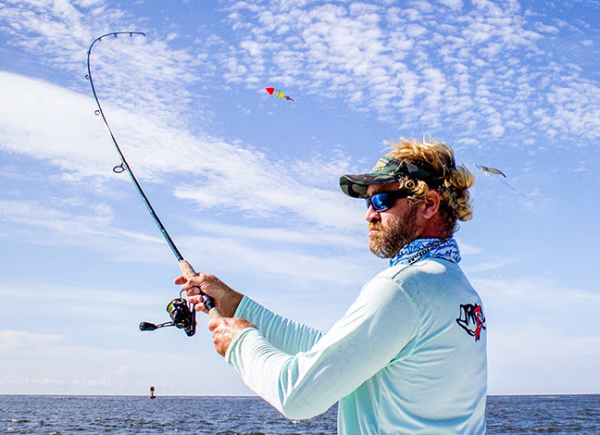 Carter is finding success on bigger trout with topwaters and suspending twitch baits, and well as Z-Man
Carter is finding success on bigger trout with topwaters and suspending twitch baits, and well as Z-Man  Brown touts sight fishing the flats this time of year when conditions are favorable. “I like to pair a 3000 series spinning reel with a St. Croix 7’, medium-light power, new
Brown touts sight fishing the flats this time of year when conditions are favorable. “I like to pair a 3000 series spinning reel with a St. Croix 7’, medium-light power, new 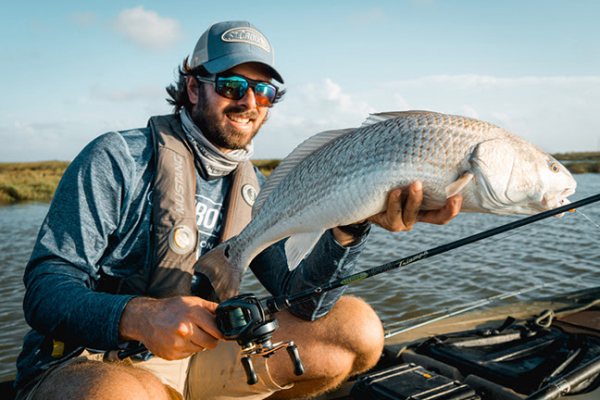 Sanderson drills down on Triumph Inshore’s varied handle options. “I preferred the 7’ version a bit better with the longer, full cork handle because I prefer to cast with two hands, but found the shorter-handled 6’8” split-grip an ideal option for wading. It’s rare to find a casting rod that performs with the lightweight jigs and baits I use so much of the time, and both of these rods excelled.”Sanderson and Gonzalez were impressed with the new Triumph Inshore rods from the start. “When I unpackaged these rods, the first thing I noticed was the surprisingly high quality of the cork and their beautiful finish,” Sanderson says.
Sanderson drills down on Triumph Inshore’s varied handle options. “I preferred the 7’ version a bit better with the longer, full cork handle because I prefer to cast with two hands, but found the shorter-handled 6’8” split-grip an ideal option for wading. It’s rare to find a casting rod that performs with the lightweight jigs and baits I use so much of the time, and both of these rods excelled.”Sanderson and Gonzalez were impressed with the new Triumph Inshore rods from the start. “When I unpackaged these rods, the first thing I noticed was the surprisingly high quality of the cork and their beautiful finish,” Sanderson says. 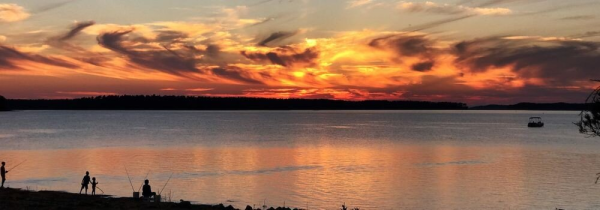 Photo courtesy Old 96 Tourism District
Photo courtesy Old 96 Tourism District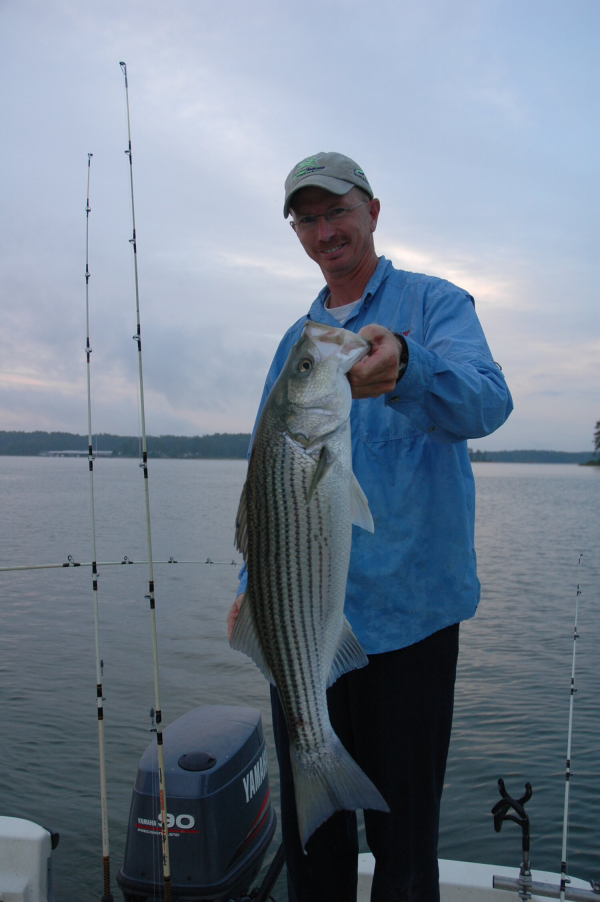 Striped and hybrid bass stocked in the lake by SCDNR’s Freshwater Fisheries Section can be successfully targeted nearly year-round at Lake Thurmond. [photo by David Lucas, SCDNR]
Striped and hybrid bass stocked in the lake by SCDNR’s Freshwater Fisheries Section can be successfully targeted nearly year-round at Lake Thurmond. [photo by David Lucas, SCDNR]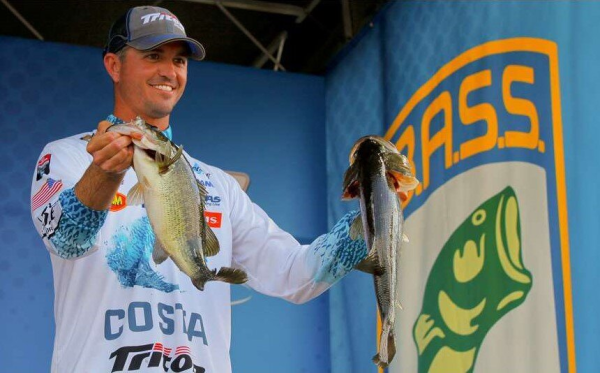 S.C.-based professional bass angler Casey Ashley knows Lake Thurmond and advises fishing deepwater structure when the weather turns hot. [photo courtesy Bassmaster]
S.C.-based professional bass angler Casey Ashley knows Lake Thurmond and advises fishing deepwater structure when the weather turns hot. [photo courtesy Bassmaster]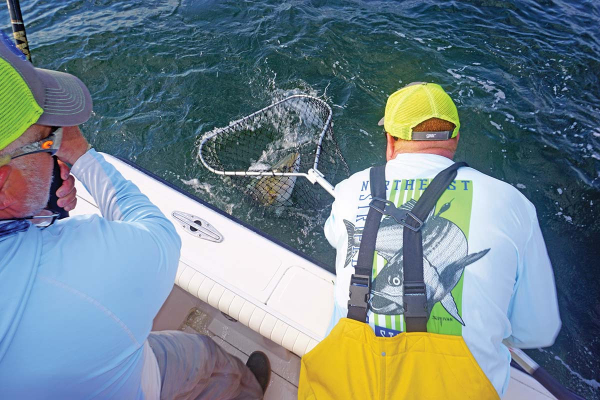 Chuck Many nets a good fish for Dave Glassberg during the spring run off the Jersey Shore during the 2020 Northeast Striped Bass Study.
Chuck Many nets a good fish for Dave Glassberg during the spring run off the Jersey Shore during the 2020 Northeast Striped Bass Study.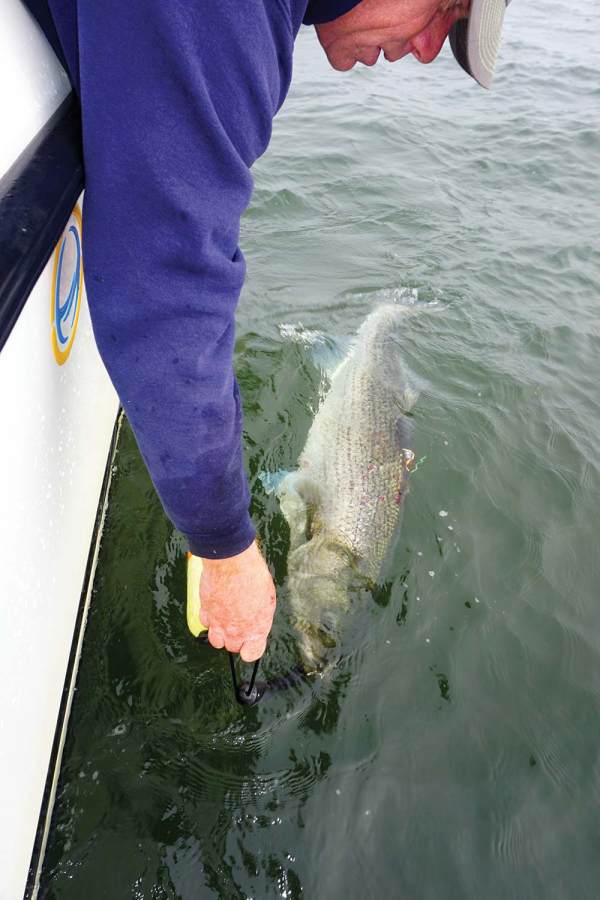 With both a MiniPSAT device and a Gray FishTag Research “streamer” tag, a 46-1/2-inch striped bass called Rona is released back in the waters off Sandy Hook for the start of her tracking adventure.So the $10,000 question we’ve all been waiting to answer with baited breath; where did Cora and Rona eventually get to, and did they follow a similar offshore path to what Freedom and Liberty did during the 2019 study?
With both a MiniPSAT device and a Gray FishTag Research “streamer” tag, a 46-1/2-inch striped bass called Rona is released back in the waters off Sandy Hook for the start of her tracking adventure.So the $10,000 question we’ve all been waiting to answer with baited breath; where did Cora and Rona eventually get to, and did they follow a similar offshore path to what Freedom and Liberty did during the 2019 study? 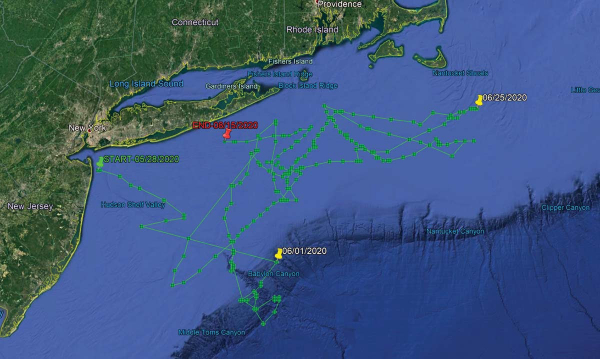 The first striper deployed with a MiniPSAT device in 2020, Rona shows a rather incredible migratory journey between May 28 and August 15.
The first striper deployed with a MiniPSAT device in 2020, Rona shows a rather incredible migratory journey between May 28 and August 15.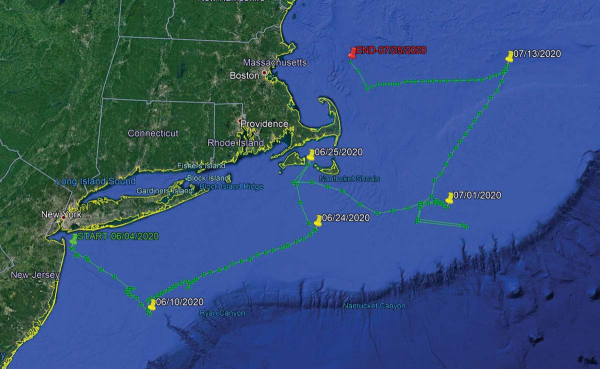 While Cora was the second fish “sat” tagged on June 3, hers was the first MiniPSAT to “ping” the Argos satellite on August 1 after coming undone prematurely on July 25.And similar to Cora which traversed darn close to the Texas Tower, data shows Rona making a quick run southwest of the Hudson tip in the area around the Triple Wrecks where yellowfin action was completely off the charts in 2020 with pelagics gorging on sand eels and keeping rods bent through early fall.
While Cora was the second fish “sat” tagged on June 3, hers was the first MiniPSAT to “ping” the Argos satellite on August 1 after coming undone prematurely on July 25.And similar to Cora which traversed darn close to the Texas Tower, data shows Rona making a quick run southwest of the Hudson tip in the area around the Triple Wrecks where yellowfin action was completely off the charts in 2020 with pelagics gorging on sand eels and keeping rods bent through early fall. 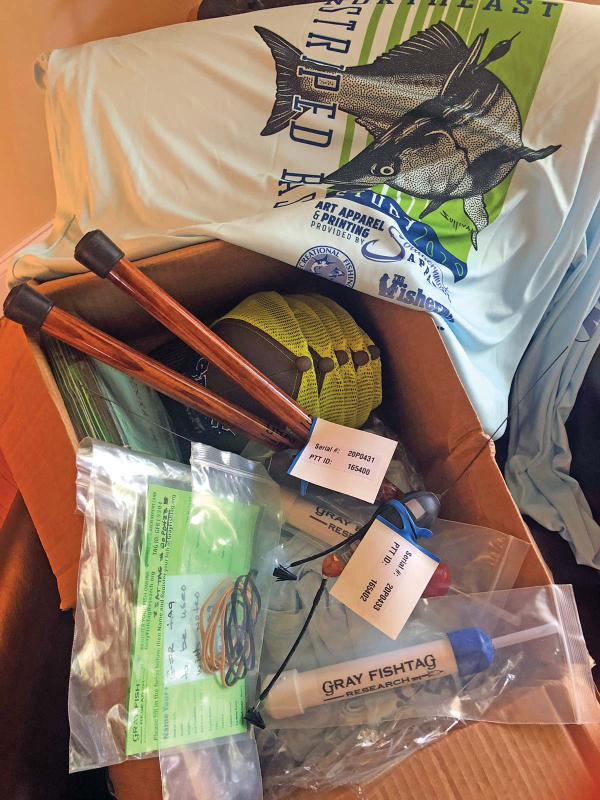 While a global pandemic impacted scheduling of the 2020 Northeast Striped Bass Study, the first batch of tagging gear arrived just in time for the Memorial Day weekend.“It is our team’s mission in our tagging work to always keep the data collected as open access to all,” Dobbelaer said of the team’s research, adding
While a global pandemic impacted scheduling of the 2020 Northeast Striped Bass Study, the first batch of tagging gear arrived just in time for the Memorial Day weekend.“It is our team’s mission in our tagging work to always keep the data collected as open access to all,” Dobbelaer said of the team’s research, adding 